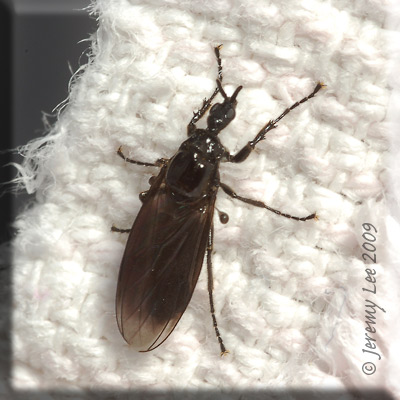
 |
|
Scientific Classifications explained » Amphibians » Ants » Aphids » Bees » Beetles » Birds » Bugs » Butterflies » Caterpillars » Damselflies » Dragonflies » Earwigs » Flies » Frog/Leafhoppers » Fungi » Galls » Grasshoppers » Harvestmen » Hoverflies » Lacewings » Ladybirds » Leaf Mines » Lichens » Mammals » Millipedes » Mosses » Moths » Sawflies » Slugs » Snails » Spiders » Trees & Shrubs » Wasps » Wild Flowers » Woodlice » Postboxes |
UK Nature > Flies > Dilophus febrilis

Scientific Name: Dilophus febrilis Common Name: Fever Fly Dilophus febrilis, more commonly known as the Fever Fly, is our most widespread bibionid and the most abundant in many areas. It is the largest Dilophus (wing length up to 7mm), overlapping in size with the smaller Bibio species such as ferruginatus and nigriventris. Females (pictured above) are easily distinguished from other Dilophus by the darkened wings with clear tips, males having clear wings and large heads. Under the microscope, both sexes have a unique arrangment of large blunt spines on the front tibiae. Dilophus febrilis occurs in a wide variety of habitats and has two generations a year, the first peaking in May and early June and the second in July and August, and specimens can even be found into October. Adults can congregate in large numbers on the flowers of umbellifers such as Cow Parsley and Alexanders in spring and Angelica and Wild Parsnip in late summer. |
|

https://www.uknature.co.uk is a website dedicated to showing the immense diversity of UK nature and wildlife. Our vast range of habitats, from lowland arable to snow covered mountains, from storm-ravaged coastlines to peaceful inland freshwater lakes and rivers, from dry, sandy heaths to deciduous and coniferous forests, all these habitats contribute to the abundance of UK nature. We have wild birds in huge numbers either residing or visiting our shores (597 recorded species as at July 2013) and we must also not forget the humble back garden with its grass lawns, flower beds filled with nectar rich flowers, shrubs and trees, all designed to attract huge numbers of insects such as bees, moths, butterflies and hoverflies; and finally the small ponds which provide safe havens for frogs, toads, newts and even slow worms and grass snakes. www.uknature.co.uk is the showcase for my personal passion, photographing uknature in all its glory. I sincerely hope you all enjoy the fruits of my labours. This site and all images contained therein is © Jeremy Lee 2004 - 2025. All Rights Reserved. Site design by Jeremy Lee. Site development & IT Support by Stuart Lee. |